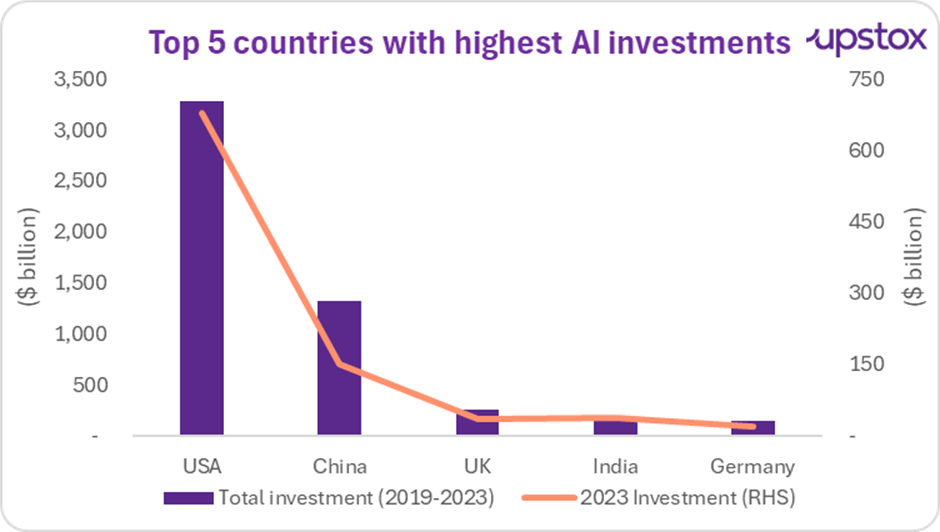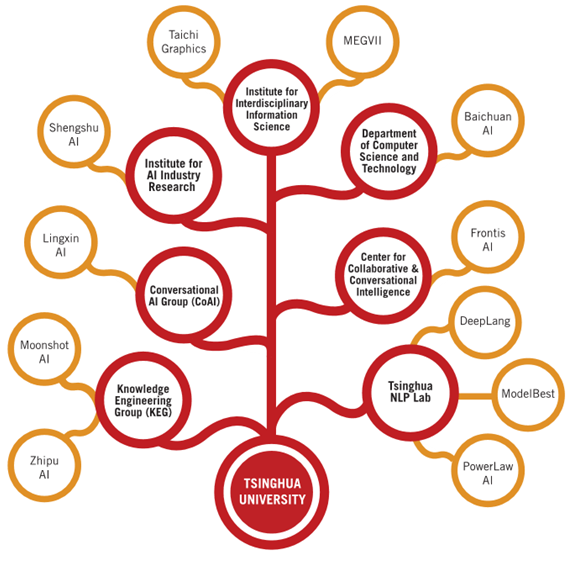Upstox Originals
Global AI race: Where does China stand?
.png)
6 min read | Updated on February 10, 2025, 14:09 IST
SUMMARY
After America, China is making significant strides in the global AI landscape. Powered by supportive infrastructure, government support, research rigour, and private sector innovation, the country is well placed to compete in the global AI race. In this article, we provide an in-depth analysis of China’s AI industry, highlighting its current advancements while also addressing the key challenges it must overcome to ensure long-term success.

Over FY19-23, China has invested ~$1 trillion in AI, second only to the USA
While DeepSeek’s accomplishments are commendable, this prompts us to examine the overall AI industry in China and compare it with its chief competitor - the USA
Global AI landscape
For the five years from 2019-2023, America has led the world in terms of AI investment and innovation. It has invested over $3.0 trillion to build overall AI capacity from chips to AI models. Following America is China, a distant second, which has invested over $1.0 trillion in AI development. So far, much of the global race for AI leadership is between these two countries.

Source: OECD and World Bank
Besides investment, we dig a little deeper to look at other nuances of AI development and how these countries stack up against each other. As per the table below, while China leads the world in AI research, the US has demonstrated better execution abilities.
| USA | China | |
|---|---|---|
| Number of AI companies (2014-2024) | 9,500 | 1,944 (Mainland) |
| Notable machine learning models (as of Nov 2024) | 61 | 15 |
| Patents filed (2014-2023) | 6,276 | 38,210 |
Source: Stanford University, WIPO, ITIF
Presently, America clearly dominates the global AI landscape. But China is catching up!
AI in China
China is becoming one of the most important countries in AI. Per new articles, China has committed to invest ~$140 billion to boost AI growth and is expected to invest about $1.4 trillion by 2030.
China’s private sector is also rising to the occasion. Besides giants like Alibaba and Baidu, multiple startups have emerged over the past years. These companies have raised significant capital to support innovation and are at the forefront of China’s AI endevours. A few such startups have been mentioned below
Major Chinese AI startups*
| Company | Major investors* | Valuation ($ billion) |
|---|---|---|
| Moonshot | Alibaba, Ant Group, Sinovation Ventures | 3.3 |
| Baichuan AI | Alibaba, Tencent, Xiaomi, Joy Capital | 2.8 |
| Zhipu AI | Alibaba, Tencent, Xiaomi, Ant Group | 2.7 |
| MiniMax | Tencent, MiHoYo, GL Ventures | 2.5 |
| 01.A1 | Alibaba, Sinovation Ventures | 1.0 |
| ModelBest | Zhipu AI, HongShan | 0.3 |
| iFLYTEK | China Mobile, Anhui Development, | NA |
Source: NBR, Crunchase, Pitchbook, CBInsights; *Only a few investors highlighted
Besides investments, as per a WEF report in January 2025, some of the major enablers for China’s AI success are:
-
Infrastructure: China has 26% of the world’s total computing as of June 2024
-
Data: China’s data volume is growing at a rate of 26% per annum (from 24 ZB in 2022 to an estimated 77 ZB by 2027)
-
Energy: As AI advances, its energy demands will surge. Research suggests that energy requirements for foundation models could surge as much as 33x from the current requirement. In response, China is advancing sustainable energy infrastructure. China is projected to account for ~60% of all renewable energy capacity installed globally between now and 2030. In 2023, the country also saw a 22% YoY increase in the total number of national green data centres.
-
Talent: 47% of the world’s top AI researchers are now in China.
With regards to talent, contributions of the Tsinghua University are worth discussing.
Contributions of the Tsinghua University
The university has been critical to China’s AI success. It has been offering courses in artificial intelligence since 1979. Over the years, it has supported multiple AI endeavours in China, by providing them with talent, research resources, and funding through the university’s investment vehicles.
For example, Zhipu AI was directly incubated within its research labs. Other more notable companies like Baichuan AI, Moonshot AI, and MiniMax were all founded by the Tsinghua faculty or alumni.
The “2024 AI Index Report” published by Stanford ranks this university at the sixth rank for the number of foundational models produced. The university has produced seven foundational models - most of any non-western institution
Tsinghua University and its contribution to AI

Source: ITIF
Finally, we look at some of the most noteworthy models that are shaping China’s tech landscape.
Famous China AI labs
| Models | Description |
|---|---|
| Qwen Series | Developed by Alibaba, is well-regarded for its ability to analyse both images and text, and its reasoning capabilities Iterations are available under an open-source license. One notable version, QwQ ("Questions with Qwen"), focuses on reasoning. Additionally, Qwen has been trained to be fluent in languages such as Urdu and Bengali. |
| Ernie | “Ernie" refers to Baidu's large language model (LLM), essentially their version of an AI chatbot similar to ChatGPT. Is known as "Ernie Bot" and is designed to generate text, answer questions, and perform various language tasks. |
| Sunshine Zhengyan GPT | It is an LLM developed by Sunshine Insurance Group. It combines proprietary data with sector-specific applications to enhance customer service, sales support, and intelligent claims processing. This model has improved information extraction accuracy by 15% compared to the pre-trained language model BERT Is used in over 80% of injury claims cases handled by the firm, achieving a 96% accuracy rate in document classification |
| Kimi k1.5 | Launched by Moonshot AI. It is being considered as a direct competitor to OpenAI’s GPT-4o Kimi can process and reason across text and images, (unlike DeepSeek-R1) |
Source: The Economist, News articles
Outlook
AI is in its nascent stage as of now. As such, while America definitely leads the world in AI as of today, success and leadership are not guaranteed in the future. As more resources (money, talent, and infrastructure) are devoted to this segment, countries will find innovative methods to come up with disruptive solutions such as DeepSeek’s R1. To that end, China remains well-poised to compete in the global AI race.
That said, similar to most countries, the Chinese AI industry also faces multiple hurdles, with government intervention being one of them. With strong government regulations around free speech, faith in the responses of Chinese AI models is likely to be diminished. There are also geopolitical concerns the country and its players must contend with. More than 6 major countries have already banned DeepSeek on data privacy concerns. While we do not comment on the political aspects of this, the reality is - it is a challenge these players will have to overcome.
Besides this, cultivating talent, and building infrastructure also remain key challenges. These are however in the country’s control and it is working to quickly overcome them
By signing up you agree to Upstox’s Terms & Conditions
About The Author
Next Story
